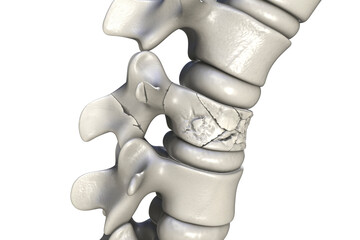In simple words, a spinal fracture happens when you break a vertebrae (one of the bones that make up your spine). This can happen as a result of compression of the spine in the case of osteoporosis, or from an accident or trauma to the spine. These fractures can be minor to severe, depending on the cause.
What Are the Different Types of Spinal Fractures?
- Compression fracture: This type of fracture is caused by excessive pressure on the vertebrae. This is more common in patients with osteoporosis or people with thinner bones. When the vertebrae are exposed to more stress due to a sudden external force, they can fracture.
- Burst fracture: A burst fracture is caused by extreme force on the vertebrae from severe trauma. In this case, the vertebra is fractured in multiple places. Fragments of bone can also cause damage to the spinal cord.
- Flexion-distraction fracture: These fractures are caused due to excessive bending of the spine. For example, a car crash can cause the spine to bend forward and put a significant amount of stress on the vertebrae. This type of fracture occurs at the posterior and middle part of the spine.
What Are the Symptoms of a Spinal Fracture?
Symptoms of a spinal fracture may vary depending on the type of fracture and its severity. Also, not all fractures are painful, so it is possible to have a fracture after an incident and feel no pain.
The most common symptoms of spinal fractures are:
- Lower back pain, dull or chronic
- Neck pain
- Swelling
- Muscle spasms
- Weakness
A fracture may also cause nerve damage and/or compress the spinal cord. This may give rise to neurological symptoms such as:
- Weakness and difficulty moving
- Bowel/bladder problems
- Numbness in arms and legs
- Paralysis (rare cases)
What Causes Spinal Fractures?
A spinal fracture can occur when an external force such as an accident or trauma affects the vertebrae. The external force, when too much for the bones, causes them to crack or break. The cracks can be at one or multiple places in the vertebra.
Patients suffering from osteoporosis, a condition that causes the bones to become weak, are at a greater risk of having a spinal fracture. Bone cancer and spinal tumors can also put people at a higher risk of a fracture.
How Are Spinal Fractures Diagnosed?
Your doctor will order imaging tests if they suspect a fracture after reviewing your medical history and performing a physical exam. These tests may include x-rays, MRIs, or CT scans to detect the fracture and the extent of its severity. Multiple tests may be required to see various parts of the spine from different angles.
What Is the Treatment for a Spinal Fracture?
There are different ways to treat a spinal fracture depending on the type of fracture and its severity:
- Braces: Braces or corsets may be used to allow your spine to heal. The brace is placed to ensure the spine maintains its natural alignment while being immobilized during the healing process. The restricted mobility also helps reduce pain. The brace is usually kept in place for a period of 8-12 weeks.
- Spinal fusion: Spinal fusion is a process to surgically merge two or more vertebrae using instruments such as metallic plates, screws, rods, hooks, or cages. The aim is to create one solid piece of bone to improve spinal structure and stability.
- Kyphoplasty & Vertebroplasty: These minimally invasive procedures (usually done at the same time) are used to treat mainly compression fractures. With kyphoplasty, a balloon is first inserted and inflated to expand the compressed vertebra. Once there is space within the vertebra, vertebroplasty can take place, where bone cement is then injected using a hollow needle to stabilize the vertebra.

